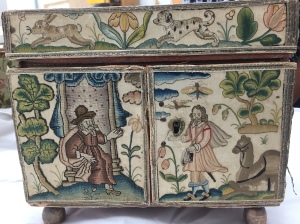
The Bourne Casket is the work of Eunice Bourne, the wife of Thomas Bourne of Bourne End and is dated to around 1660. The casket is not on public display but Eleanor Palmer very kindly arranged for us to have a private viewing and demonstrated all the drawers and trays within the casket. Unfortunately the museum has now been closed owing to government and local authority austerity cuts, but it is open for school visits and research.
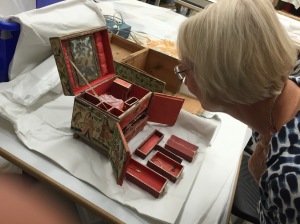
We were fortunate to see the contents of the casket with many trays, some containing beautiful toys.
The casket is stored in a wooden box (seen at the back) which has helped to preserve the colours from light damage. The case is covered in 18th century hand painted paper.
The casket tells the story of Abraham, Isaac and Rebecca. Amanda Pullan has written a paper on this casket (Pullan, A. (2014) ‘Needlework and Moral Instruction in English Seventeenth-Century Households: the Case of Rebecca’, Studies in Church History, 50, pp. 254–268. doi: 10.1017/S0424208400001753.) and we have used her work in our comments.
All the photos were taken by the authors with the Permission of the Museum of Lancashire.
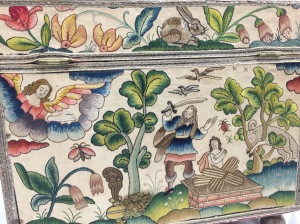
The sacrifice of Isaac is depicted on the rear panel with a beautiful ram caught in the bush, ready to be substituted for Isaac. Genesis 22.
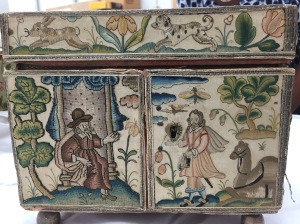
The front panels show Abraham sending out his servant Eliezer to search for a wife for Isaac. Genesis 24.
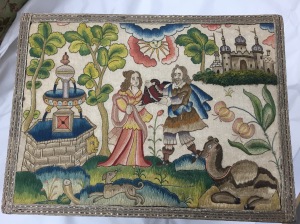
The top main panel shows the key scene of Rebecca industriously bringing water for Eliezer to drink, with one of the camels waiting its turn.
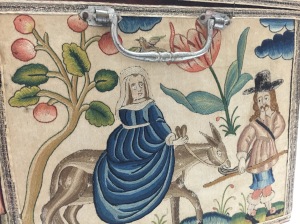
Fitting in with the Rebecca theme this side panel embroidery depicts Rebecca travelling back with the servant Eliezer to meet her betrothed Isaac.
Controversially Amanda Pullan suggests that at the same time Eunice Bourne has chosen to portray the Virgin Mary travelling with Joseph. The striking blue gown and the donkey point to this possibility, but New Testament themes are very rare on 17th century caskets. It is possible that this is Catholic symbolism – four members of the Bourne family refused to take the protestant oath in 1641.
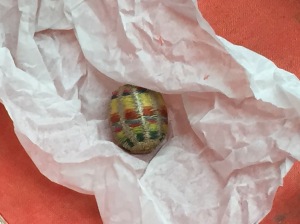
This is further suggested by the embroidered ovoid that hides in a secret compartment within the casket. This is said to contain an acorn from the Boscobel Oak tree in which Charles II hid from the roundheads following the Battle of Worcester in 1651.
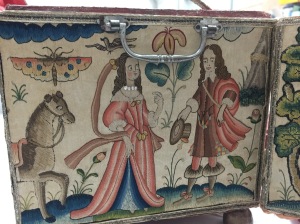
The final side panel is rather sexually explicit for a young girl’s embroidery in the 17th century. Rebecca is holding up her skirt to reveal the underskirts below while at the same time giving a clear invitation to Isaac with her beckoning finger.